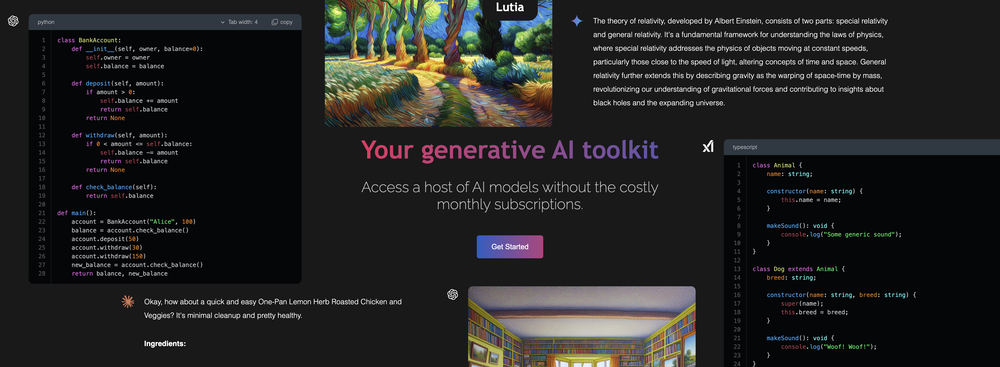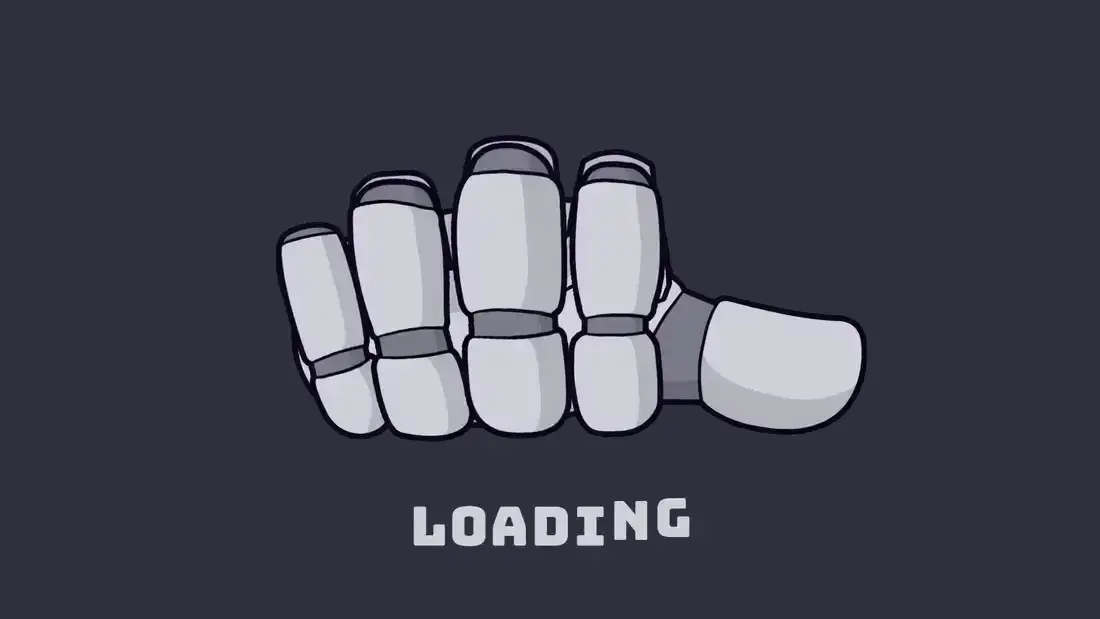▼ State of the art
Unbloc
Free mode
100% free
Freemium
Free Trial
Other tools
-
30,14333Released 2mo agoFree + from $97/mo
 Vincent JOSSE🛠️ 1 tool 🙏 54 karmaAug 19, 2025Hey TAAFT 👋 I'm Vincent, the founder of BlogSEO. I created BlogSEO with one goal in mind: automating SEO for busy entrepreneurs. As a multiple-time founder myself, I never had the time to take care of SEO for my past projects. I knew SEO was one of the most efficient acquisition channel, but I just couldn't spend time creating content and setting up a blog for my projects. I was busy building the features, answering customers and running the business. That's why I created BlogSEO. For ambitious builders and business owners that know the power of ranking on Google and getting cited by ChatGPT to get leads, but don't have the time to take care of it. BlogSEO fully automates your SEO strategy: you just need to put your website URL, connect it in a few clicks and fresh SEO-friendly content will start appearing on your website daily. BlogSEO was designed to really work for you and not the other way around, that's why it works out of the box with 0 setup and is fully automated by default. But if you prefer to have more control over your content, you're able to do so by customizing keywords, targeting competitors and review the SEO content before it's published. I hope this tool will help you as much as it helps me getting organic traffic on my websites! Keep Scaling 🚀! Vincent
Vincent JOSSE🛠️ 1 tool 🙏 54 karmaAug 19, 2025Hey TAAFT 👋 I'm Vincent, the founder of BlogSEO. I created BlogSEO with one goal in mind: automating SEO for busy entrepreneurs. As a multiple-time founder myself, I never had the time to take care of SEO for my past projects. I knew SEO was one of the most efficient acquisition channel, but I just couldn't spend time creating content and setting up a blog for my projects. I was busy building the features, answering customers and running the business. That's why I created BlogSEO. For ambitious builders and business owners that know the power of ranking on Google and getting cited by ChatGPT to get leads, but don't have the time to take care of it. BlogSEO fully automates your SEO strategy: you just need to put your website URL, connect it in a few clicks and fresh SEO-friendly content will start appearing on your website daily. BlogSEO was designed to really work for you and not the other way around, that's why it works out of the box with 0 setup and is fully automated by default. But if you prefer to have more control over your content, you're able to do so by customizing keywords, targeting competitors and review the SEO content before it's published. I hope this tool will help you as much as it helps me getting organic traffic on my websites! Keep Scaling 🚀! Vincent -
30,14333Released 2mo agoFree + from $97/mo
 Hey TAAFT 👋 I'm Vincent, the founder of BlogSEO. I created BlogSEO with one goal in mind: automating SEO for busy entrepreneurs. As a multiple-time founder myself, I never had the time to take care of SEO for my past projects. I knew SEO was one of the most efficient acquisition channel, but I just couldn't spend time creating content and setting up a blog for my projects. I was busy building the features, answering customers and running the business. That's why I created BlogSEO. For ambitious builders and business owners that know the power of ranking on Google and getting cited by ChatGPT to get leads, but don't have the time to take care of it. BlogSEO fully automates your SEO strategy: you just need to put your website URL, connect it in a few clicks and fresh SEO-friendly content will start appearing on your website daily. BlogSEO was designed to really work for you and not the other way around, that's why it works out of the box with 0 setup and is fully automated by default. But if you prefer to have more control over your content, you're able to do so by customizing keywords, targeting competitors and review the SEO content before it's published. I hope this tool will help you as much as it helps me getting organic traffic on my websites! Keep Scaling 🚀! Vincent
Hey TAAFT 👋 I'm Vincent, the founder of BlogSEO. I created BlogSEO with one goal in mind: automating SEO for busy entrepreneurs. As a multiple-time founder myself, I never had the time to take care of SEO for my past projects. I knew SEO was one of the most efficient acquisition channel, but I just couldn't spend time creating content and setting up a blog for my projects. I was busy building the features, answering customers and running the business. That's why I created BlogSEO. For ambitious builders and business owners that know the power of ranking on Google and getting cited by ChatGPT to get leads, but don't have the time to take care of it. BlogSEO fully automates your SEO strategy: you just need to put your website URL, connect it in a few clicks and fresh SEO-friendly content will start appearing on your website daily. BlogSEO was designed to really work for you and not the other way around, that's why it works out of the box with 0 setup and is fully automated by default. But if you prefer to have more control over your content, you're able to do so by customizing keywords, targeting competitors and review the SEO content before it's published. I hope this tool will help you as much as it helps me getting organic traffic on my websites! Keep Scaling 🚀! Vincent -
3,55047Released 7mo agoFree + from $1My favourite AI application. Great clean UI and even better pricing.
-
3,55047Released 7mo agoFree + from $1
 My favourite AI application. Great clean UI and even better pricing.
My favourite AI application. Great clean UI and even better pricing. -
 AI-powered anime and comics made easy—create, customize, and share your stories effortlesslyOpen76,202294Released 6mo agoFree + from $10/moVery good AI Comic generator.It can easily create comic scripts and images and the effect is good.
AI-powered anime and comics made easy—create, customize, and share your stories effortlesslyOpen76,202294Released 6mo agoFree + from $10/moVery good AI Comic generator.It can easily create comic scripts and images and the effect is good. -
 AI-powered anime and comics made easy—create, customize, and share your stories effortlesslyOpen76,202294Released 6mo agoFree + from $10/mo
AI-powered anime and comics made easy—create, customize, and share your stories effortlesslyOpen76,202294Released 6mo agoFree + from $10/mo Very good AI Comic generator.It can easily create comic scripts and images and the effect is good.
Very good AI Comic generator.It can easily create comic scripts and images and the effect is good. -
9,97325Released 1y agoFrom $25/moFast updates, and every ai image and video model imaginable
-
9,97325Released 1y agoFrom $25/mo
 Fast updates, and every ai image and video model imaginable
Fast updates, and every ai image and video model imaginable - Sponsor:Rocket
-
76,65593v2.1 released 28d agoFree + from $20/moStakly helped me launch my app super fast. Really impressed with how easy it was to use.
-
76,65593v2.1 released 28d agoFree + from $20/mo
 Stakly helped me launch my app super fast. Really impressed with how easy it was to use.
Stakly helped me launch my app super fast. Really impressed with how easy it was to use. -
4,4867Released 2mo agoFree + from $149I am a SRED consultant. The ability to upload documents and instantly get SR
-
Open12,89116Released 1mo agoFree + from $10/moBriefNest is a very useful tool for quickly generating strategic and creative briefs in a professional format. The interface is clear, the bilingual support is a big plus for international clients, and the ready-to-deliver PDFs make the workflow much easier.
-
21,06897Released 11mo agoFree + from $0.01
-
1,1789Released 1mo agoFree + from $4.90
-
Open36,00653Released 2mo ago100% FreeHi all, this is our contribution for the community (free tool)! Let us know what you think and please stay tuned for our desktop overlay! Also please visit our discord to drop us some messages :)
-
10,75811Released 6mo agoFree + from $19.99/mo
-
21,13465Released 5mo ago100% Free
- Didn't find the AI you were looking for?
-
Legal services, advice, documents drafting, & contracts for SMBs and startupsOpen20,295492v2.1.1 released 5mo agoFree + from $49.99/mo
-
2,64812Released 2y agoFree + from $38/mo
-
36,834153v1.2 released 4mo agoFree + from $49.99Much more in-depth and relevant outputs from my existing chatGPT from the first interaction.
-
25,41829Released 4mo agoFree + from $99/moThanks for the feedback! Would love to hear what you’d like to see next
-
20,96326Released 2mo agoFree + from $30/moHello everyone, As a AI power user, I constantly faced the multi-tab scramble and the uncertainty of getting truly reliable answers from various AI tools. That frustration led me to build Singulairity AI. My goal was simple: to create a unified, intelligent, and trustworthy platform where you can access leading AI models with unprecedented clarity and efficiency. I poured my efforts into features like Intelligent Auto-Routing, Side-by-Side Response Comparison, and the innovative Truth Mode to give you the confidence I always sought. I truly hope Singulairity AI enhances your workflow. Please review the tool and share your invaluable feedback; it's essential for Singulairity's continued evolution.
-
4009Released 2mo agoFrom $9/mo
-
 AI automates startup fundraising from pitch to investor match.Open25,54060Released 2mo agoFree + from $10/moInstead of wasting weeks searching, Evalyze did the hard work for us. Just from our deck, it matched us with investors that aligned exactly with what we’re building. A total game-changer.
AI automates startup fundraising from pitch to investor match.Open25,54060Released 2mo agoFree + from $10/moInstead of wasting weeks searching, Evalyze did the hard work for us. Just from our deck, it matched us with investors that aligned exactly with what we’re building. A total game-changer. -
AI-powered candidate screening with instant results.Open1,0445Released 1mo agoFree + from $13.99/moGreat app! User-friendly design, smooth performance, and all the tools I need are easily accessible. Highly recommend!
-
1,7414Released 1mo agoFrom $99By far the best test automation platform! I no longer waste hours writing test code—this AI handles everything. When something breaks, I can see it instantly and fix it. My productivity has easily doubled since I started using it!
-
40,76024v1.6 released 1mo agoNo pricing
-
3,4855Released 1mo agoFree + from $49.99/moI had a really good experience with Decory. Out of the tools I’ve tried, it’s probably the easiest and most straightforward to use. The interface is simple, so I didn’t feel overwhelmed, and I liked how quickly it generated room designs. What I personally found most useful was the option to buy items directly through the app — it saved me the hassle of searching for similar furniture elsewhere. Overall, it’s a practical tool that I’d recommend to anyone looking for quick design ideas.
-
Turn your shared inbox into an automated revenue engineOpen24,34516v3.0 released 25d agoFree + from $39/mo
-
18,56020Released 16d ago100% Free
-
14,83515Released 16d agoFree + from $49I’m allergic to synthetic data, but I gave FirstSign a spin and… my calendar sent a thank-you note. Skipped the cold DMs and got surprisingly sharp interviews for early validation. Feels like cheating, but I’ll allow it ;)
-
1,0983Released 9d agoFree + from $60/mo
-
15,91625v0.3 released 12d agoFree + from $20/moThere is nothing like that out there, especially with a high voice-based translation quality (including with specific terminology). As the Product Manager, I am a bit biased, but I still think it is great for live interpretation :)
-
30,25683v3.0 released 29d agoFrom $7.5/mo
-
Open275,353287v1.18.1 released 5d agoFree + from $8.25/mo🚀We are pleased to announce the official launch of remio v1.18👇 1.🌍 Ask with Live Web Search: Ask remio with the world's knowledge, even better, try all the SOTA LLMs in remio (integrated with the Sonnet 4.5). 2.📧 Sync email to expand your knowledge base. (Limited Beta Testing): Transform emails into searchable knowledge. Work emails complete your contact histories with meetings and Slack. Newsletters get personalized summaries based on your interests. (You can apply it within remio desktop app) 3.✨ Chat to any item with one click “@”: See that "@" button on every note, document, and folder? Click it to instantly start a conversation about that specific content. Ask questions, get summaries, or find connections to make every piece of content interactive.
-
Track online brand mentions with AI-powered social listening, for free.Open97612Released 1mo agoFree + from $19/mo
-
11,50143Released 1mo ago100% Free
-
2,95729Released 2mo agoFree + from $24/moIt’s a fast, sleek, and feature-rich browser that makes multitasking effortless and browsing more enjoyable. Highly recommended!
-
58,64268v1.1.1 released 1mo agoFree + from $1Thanks a lot for giving our tool a try and for the honest feedback - really appreciate it! Sorry to hear it didn’t feel different from what you’re already using, but I have an idea: how about we take one of your ICPs and do a side-by-side comparison with Lusha? I’m 100% sure we’ll beat them in terms of relevant contact density. Feel free to drop your ICP here or DM me.
-
 10X Your Clients with Your Proposal Copilot; for digital transformation consultantsOpen4,4817Released 25d agoFree + from $60/mo
10X Your Clients with Your Proposal Copilot; for digital transformation consultantsOpen4,4817Released 25d agoFree + from $60/mo -
 10X AI Adoption with Your Change Management Copilot; for digital transformation consultantsOpen6,3602Released 24d agoFrom $675.23/yr
10X AI Adoption with Your Change Management Copilot; for digital transformation consultantsOpen6,3602Released 24d agoFrom $675.23/yr -
8508Released 19d agoFree + from $336.20/yr
-
28810Released 17d agoFrom $336.91/yr
-
4055Released 14d agoFrom $60/mo
-
12,758109Released 25d agoNo pricingThe leading generative media models on fal combined with top-earning real-world creative talent on Contra is a powerful combination. Feedback to fuel the future of creative ai.
-
3,10433Released 8mo agoFree + from $17/mo
-
192,8371,083v4.0 released 5mo ago100% Free
-
 Your AI-powered personal fitness trainer.Open5,05431Released 3y agoFree + from $2.99/mo
Your AI-powered personal fitness trainer.Open5,05431Released 3y agoFree + from $2.99/mo -
13,2496Released 2mo agoFree + from $3/moHey this is Tan, I'm the creator of NotesBot. I created this tool because I needed it for my own meetings. After using myself and getting great summarization reviews from my peers, I decided to release it to the public. After release, we realized people were also using it for Dungeons and Dragons, I then added a DnD mode. This tool is non-invasive, very easy to set up, and perfect for meetings. I hope you enjoy using it!
-
5,94317Released 2mo agoFrom $20
-
26,50930Released 2mo agoFree + from $32.68/moQuick update: Verify is now live on the Microsoft Edge Add-ons store in addition to Chrome. Same one-click resume red flag check in seconds. Same free first-day trial. Now available in whichever browser your team uses most. Recruiters are already catching issues their ATS missed... sometimes on the very first resume they check. If you’ve been meaning to test it, this is your sign → https://microsoftedge.microsoft.com/addons/detail/hiiappghgofoiionoeloemlkcankbpka
-
1,43512Released 2mo agoFree + from $19.99
-
93911Released 1mo agoFree + from $15/mo
-
9,96529Released 15d agoFree + from $9.99/moHi Mike, can you give me an email to reach out to you or chat with our chatbot and ask for support and tell us you left the comment here. We block cash app for our other products because of fraud but will make it work for you!
-
2,8251Released 4d agoFree + from $29/moHello, I'm the founder of this tool. It's currently in its early stages, but we are actively developing and refining it. Give it a try and share your thoughts!
-
18,05527v2.0.0 released 5d agoFree + from $19/moBuild new websites and apps. Or modify your existing ones. No coding skills or setup required. With live preview, see your changes instantly. Comes with an integrated backend, a visual QA tester that tests every change visually and the ability to generate images/videos directly from chat.
-
3135Released 2d agoFree + from $4.99/mo
-
2222Released 2d agoFree + from $10/mo
-
1,0643Released 3mo agoFree + from $14/mo
-
Empowering Organizations to Achieve Compliance ReadinessOpen45416Released 11d ago100% FreeI used this tool today and loved how simple and insightful it was!
-
11,23723Released 3mo agoFree + from $33/mo
-
Create custom AI gaming companions with voice chat and live screenshare.Open8,6436Released 4d agoFree + from $10/mo
-
4,11429Released 4mo agoFree + from $25/mo
-
11,70130Released 6mo agoFree + from $7/mo
-
Turn your ideas into stunning, custom phone cases - instantly, with AI.Open14,98637Released 7mo agoFree + from $27.99
-
 Prevent AI data breaches with real-time risk management.Open2,39760v2.1 released 4mo agoNo pricingNot just alerts - real time visibility for Slack, Google Workspace, and AI APIs to stop risks before they become breaches
Prevent AI data breaches with real-time risk management.Open2,39760v2.1 released 4mo agoNo pricingNot just alerts - real time visibility for Slack, Google Workspace, and AI APIs to stop risks before they become breaches -
18,906617Released 1y agoFree + from $29/moI've been playing around with this for a few hours. It's made me say "WOW" too many times than i wish to admit. I'm going to follow this and see how it evolves. For now, i managed to create quite a nice Expenses app for personal use. | It did have some problems when it came to moving some components on other pages, but for how short the prompts it uses can be, it is really impressive. With some proper prompts it can generate some strong stuff.
-
1,62943Released 3mo agoFree + from $99
-
10,32313Released 3mo agoFree + from $9/moHi folks - I'm Charles, the founder of Wizardly. As a sales guy I originally built this app to create training videos for sales reps 10X faster. Many friends started using Wizardly to create all sorts of tutorials for tools I'd never heard of. Excited to get feedback and hear how I can make this app the best how-to video generator on the market.
-
73417Released 1mo agoFree + from $22/mo
-
Open6,6091Released 24d agoFree + from $59/mo
-
55,2241,624Released 2y agoFrom $6/moIt's sad to see people want to try your tool out but you have no free sample for them. This may be the best tool out there, but, as mentioned, going through with the AI for minutes to explain what you want, then being prompted to pay, without even knowing if it CAN create something, is discouraging. I hope we can get a free sample or preview at one point, im interested in this one.
-
6,83211Released 17d agoFree + from $74/moThis tool is awesome! The metrics are really interesting and useful.
-
Open2,66214Released 8d agoFree + from $24/moHey everyone! I’m Evaldas, co-founder of Guideless - the fastest way to turn any browser workflow into a polished, AI-narrated video guide in minutes. No screen recording. No tedious editing. Just turn on the extension, click through your process as you normally would, and instantly get a share-ready guide. We recently shipped a major update: a sleeker UX and new high-quality AI voiceover characters , making guides sound and feel more vibrant. Give Guideless a try and see how effortless creating high-quality tutorials can be 🪄
-
1804Released 1d agoNo pricing
-
31,21852v2.0 released 26d agoFree + from $35/moThis is a fantastic tool for creating a bespoke chatbot that understands the nuances of your business. It's so easy to set up, works with all the platforms I use, like Slack, Google Drive, Notion, and Zapier, and it's massively helped with customer service queries. Would definitely recommend.
-
14,1503Released 26d agoFree + from $16.48/mo
-
9189Released 5mo agoFree + from $12/moA lot of humanizer software is actually just gpt wrappers to do this by asking gpt to rewrite with some different voice. Ace Essay does have their own AI that does a better job at humanizing.
-
20,835710Released 2y agoFree + from $3.99/moVery cool app! Build was fast as, and with a few tweaks I fully launched my website in 1 hour!
-
15,81957Released 1y agoFree + from $39/moWhatsApp and Messenger integrations don't work very well. Support team is very sporadic. Still couldn't get it to work consistently despite best effort to fix.
-
1,42518Released 3mo agoFree + from $9.99/moThis is without doubt, the fastest and easiest way to compare and test different AI models side by side
-
26,732286v1.0.1 released 1y agoFree + from $6/moIt's a fun tool to play around with. They start you with 70 credits, enough to make a model, images, and, a video.
-
87730Released 4mo agoFree + from $0.01
-
6374Released 23d agoFree + from $49.99/mo
-
10,2258Released 3d agoFree + from $4.9/mo
-
6013Released 2d agoFree + from $10.32/mo
-
 100% Free AI-powered website compliance audits in minutes.Open6,730235Released 8mo ago100% Free
100% Free AI-powered website compliance audits in minutes.Open6,730235Released 8mo ago100% Free -
16,78418Released 1mo agoFree + from $8/mo
-
14,16726Released 1mo agoFree + from $9
-
4,3984Released 1d agoFree + from $7/mo
-
14,78139Released 4mo agoFree + from $9/moHey Michael 🙂 Thanks for the honest feedback , and I totally understand where you're coming from. We recently added the tutorial to help new users understand the app quickly, but we hear you , we’ll look into making it optional. Also, just to clarify: we do offer a free plan! You should be able to create and preview documents without paying. If you ran into any issues, please reach out to us at [email protected] , we’d be happy to give you extra free credits and make things right. We’d love the chance to turn that 2⭐️ into a 5⭐️ , and your input helps us get better. Appreciate you giving it a shot! Best, The Writedoc.ai Team
-
1,6628Released 1mo agoFree + from $20/mo
-
28,49190Released 3mo agoFree + from $17/moI've been using it for a few months, primarily for research, content generation and writing for both internal docs and public posts, and searching for data from weeks prior. It's been a game changer.
-
27,854101v3.0.0 released 2mo agoFree + from $39
-
9,072253v1.0 released 5mo agoFree + from $4.95/mo
-
15,0073Released 6d agoFrom $39.99the founder is cool, definitely a recommendation if you have personal requests and grow the app along with you.
-
5,27614Released 4d ago100% Free
-
212,340933v3.4 released 17d agoFree + from $11.25/moThis tool i found is super cool, I created 5 books from this tool to sell them online, which gives me great profit. I am creating more valuable books to spread knowledge, and earn some bucks as well 🤑.
-
18,73648v2.2 released 1mo agoFree + from $11.48/mo
-
15,004137Released 9mo agoFree + from $29/moThis is not the case. You can create both a blog and a podcast with the free account. We have a support link, please use that and I would be happy to walk you through this if the videos did not help.
-
8,85699Released 8mo agoFree + from $49/moHi Rod, you did not click the "include" for each section you wanted to include. I did that for you so you can now see your page. Looks good so far.
-
1,00922Released 6mo agoFrom $24.75/mo
-
65,464171v1.3.0 released 3mo agoFree + from $19.99
-
14,54632Released 3mo agoFree + from $135/moWe’ve just launched CASi Scout — a product that helps writers generate smart, relevant content ideas based on breaking news, strategic angles, and their client’s audience and product.
-
Define your ideal customers and craft a winning marketing strategy with Elsa.Open24,780619v1.1 released 5mo agoFree + from $49/moI rarely leave reviews, but Elsa amazed me. After a few weeks of using it, I'm still excited. Props, guys.
-
3,70727Released 11mo agoFrom $20
-
25,251137v2.0 released 1mo agoFree + from $4.99/moReversed cards can help you find the hidden areas that you didn't know about.
-
1,64716Released 2y agoFrom $3
-
3,00438Released 1y agoFree + from $9.9/moas somebody else said it doesn't always follow the prompt fully (stuff like colors or body placement) but honestly mine came out actually nice, at least design wise. it missed a couple details, sure, but overall it looked fire. good starting point if youre trying to visualize an idea
-
2,67713Released 7mo agoFrom $249
-
1,45516Released 7mo agoNo pricing
-
1,45411Released 7mo agoNo pricinglook nice! I still explore more on this platform, and this tool is the first and the best one I have even used!
-
2,41143Released 7mo agoFree + from $9.99/moWho doesn’t have a never-ending list of saved items they never go back to? This app alleviates that by automatically tagging and grouping what you save. A chore becomes a joy!
-
1,15615Released 7mo agoNo pricing
-
2,16829Released 7mo agoFrom $97
-
Open1,5849Released 6mo agoFrom $5.99
-
36,06231Released 6mo agoFree + from $20/mo
-
25,82148Released 6mo agoNo pricing
-
12,82032Released 6mo agoFree + from $1.99/moDigiDish has completely revolutionized my cooking experience! The ability to snap photos of restaurant dishes or random ingredients and instantly get perfect recipes is magical. I’m constantly impressed by how the AI personalizes everything to my dietary needs, scales recipes effortlessly, and provides spot-on nutritional information. The Brainstorm Bot has saved countless ”what’s for dinner” moments, while the Chef Bot feels like having a professional guiding me through techniques. Being able to digitize handwritten family recipes with just a photo is the unexpected feature I didn’t know I needed. From meal planning to execution, DigiDish has transformed cooking from a daily chore into something I genuinely look forward to!
-
81116Released 6mo agoFree + from $50/mo
-
1,31220Released 6mo agoFrom $10As a marketing agency, ProfilelyAI has supercharged our ability to create campaigns that convert. It’s a perfect fit for marketing teams, delivering fresh audience insights through the 41 page report we got packed with actionable items and its all for just $10 per report, way more affordable than competitors. The detailed data on behaviors, pain points, and channel preferences helps us optimize campaign targeting with precision, saving time and boosting results. ProfilelyAI’s instant, high-quality insights are a marketer’s secret weapon—absolutely recommend!
-
1,03527Released 6mo agoNo pricingRecently released an AI Chat Bot for websites and was testing different models for my ”conversion-focused” approach, this would have made it so much easier! Could be interesting to be able to plug into this via API with all my data
-
1,23425Released 6mo agoFree + from $49/moAgentFuel.bot auto-generates social media content specifically for the real estate industry, has a document chat tool and the road map is super strong. If you are a commercial or residential real estate agent, mortgage loan officer or in title, anywhere in the world this tool is worth a look.
-
30,34444Released 5mo agoFree + from $10/moLike copilot, but for power users. Nice for my n8n workflows command center
-
 Your AI stream companion that entertains chat and boosts tipsOpen15,5567Released 5mo agoFrom $16
Your AI stream companion that entertains chat and boosts tipsOpen15,5567Released 5mo agoFrom $16 -
2,11616v2.0 released 2mo agoFree + from $20/yr
-
4186Released 5mo agoFrom $200/mo
-
1,95633Released 5mo agoFree + from $20/mo
-
1,68845Released 5mo ago100% FreeIt offers a quick, accessible, and discreet biblical guidance, excellent for ready-made devotions or sermon ideas.
-
1,0977Released 5mo agoFrom $300/mo
-
6293Released 5mo agoFrom $9
-
373,13246009.25 released 9d agoFree + from $20/mo
-
1,3298Released 5mo ago100% Free
-
1,2757Released 5mo agoNo pricingHey! Thanks for your interest — we’ve opened up applications for the Early Access Program of our AI Agent for Mobility and Logistics. You can apply here: https://getswitch.io/agentic-ai-for-mobility-and-logistics/
-
48314Released 5mo agoNo pricingHad an incredibly insightful meeting with the team. It’s definitely worth your attention if you’re planning to automate your property management.
-
5438Released 5mo agoFree + from $49/mo
-
1,54820Released 5mo ago#48 in Trending
-
5,1349Released 1y agoFree + from $3/mo
-
88818Released 4mo agoFree + from $49/moAhaha Sam was really nice to me, we did some brainstorming together. It s great for getting some strategies ideas, especially if you have a small business like me
-
5066Released 4mo agoFree + from $15/mo
-
1,1343Released 4mo agoFree + from $5.99/moAs someone who's worked with food businesses, I know how crucial visual appeal is for driving sales - especially in the digital space where customers make split-second decisions based on photos. What stands out to me is how this tool addresses a real pain point. Professional food photography is expensive and time-consuming, but this AI solution makes high-quality food images accessible to everyone from small restaurants to food bloggers. The instant transformation aspect is particularly valuable for businesses that need to update their menus frequently or manage multiple locations. I can see this being a game-changer for food delivery apps where compelling visuals directly impact order volume. The fact that it's specifically trained for food photography rather than being a generic photo enhancer shows thoughtful development. Would love to see some before/after examples if the developers are sharing any - the concept is solid and fills a clear market need. Definitely keeping this on my radar for future projects!
-
5526Released 4mo agoFrom $29/mo
-
Your Visitors Can Talk to Your Website. AI Answers Instantly.Open15,15014v2.1 released 1d agoNo pricingStop losing high-value leads to missed calls, slow response times, and spam. Cambir is your 24/7 AI receptionist that lives on your website—instantly capturing and qualifying every opportunity across voice and web chat. Whether you're a lawyer in court, a contractor on a job site, or a SaaS founder in meetings, Cambir responds in under 60 seconds so you only deal with serious prospects. Natural-sounding AI qualifies leads with strategic questions, filters out 90%+ of spam automatically, and books appointments to your calendar. Built for businesses where every lead counts—professional services, home services, real estate, tech companies, and manufacturing.
-
Open5765Released 4mo agoFree + from $49.99/mo
-
AI-powered gift discovery for every occasion.Open1,99522Released 4mo ago100% Freeperfect for finding gifts, no matter who it's for, the occasion or the person's hobbies! my new go-to
-
6918Released 4mo agoNo pricing
-
 Build customized Proof-of-Concepts (POCs) and full applications in hours - not weeks.Open9,90927Released 4mo agoFree + from $49/mo
Build customized Proof-of-Concepts (POCs) and full applications in hours - not weeks.Open9,90927Released 4mo agoFree + from $49/mo -
6523Released 4mo agoFrom $18
-
7717Released 4mo ago100% Freetried this tool on a random photo and it hit quick. gave me three likely matches with percents and simple care tips so i actually learned something. free and cute app
-
1,15625Released 4mo agoNo pricingIt greatly supported my R&D work by helping me tackle technical challenges and prepare reports.
-
Grotto Slice – Your Shortcut from Image to KlaviyoOpen6,34713Released 4mo agoFree + from $48/mo
-
 Open14,24831Released 4mo agoFree + from $19/moMagnetify's clean and simple interface makes it incredibly easy to jump in and start creating marketing materials. The lead magnet templates are a total game-changer for creating lead magnets to grow our list. Magnetify has already become an essential tool for our marketing strategy!
Open14,24831Released 4mo agoFree + from $19/moMagnetify's clean and simple interface makes it incredibly easy to jump in and start creating marketing materials. The lead magnet templates are a total game-changer for creating lead magnets to grow our list. Magnetify has already become an essential tool for our marketing strategy! -
95716Released 4mo agoFree + from $5/moI gain time with TopFrog! It is very helpful, and I recommend it highly!
-
44,56326v1.2.0 released 1mo agoFrom $19Thanks for the feedback. We would love to know more about your issue. Could you please provide more details at [email protected] ?
-
23,88155Released 6mo agoFree + from $2.99/moThe tools we use to showcase our professional lives are inadequate for today’s dynamic career landscape. It is a career operating system: a dynamic platform that would empower individuals to own their career stories.
-
1,3741Released 3mo agoFree + from $200/mo
-
1,38615Released 3mo agoFree + from $8.99/mo
-
1,19727Released 3mo agoFrom $160/mo
-
1,1006Released 3mo agoFrom $15/mo
-
2833Released 3mo agoNo pricing
-
5119Released 3mo agoNo pricing
-
6005Released 3mo agoFree + from $7.99/mo
-
19,80520Released 3mo agoFree + from $6.99I’ve been using Lyra as a kind of MBA writing coach—it helps structure ideas, spot what’s working in your story, and take the pressure off the blank page. Your voice is still doing the work; this just gives it a bit more shape.
-
3,75630Released 3mo ago100% Free
-
37,42841v2.6.2 released 3d agoFree + from $39/moWe've rebuilt the brief generation engine from the ground up. What's new: • Smarter AI models with real-time web data • Enhanced keyword research algorithm • Redesigned interface with faster loading and smoother workflows • 15-day trial Launch special: 50% off until October 26th.
-
8309Released 1y agoFree + from $9/mo
-
1,2808Released 3mo agoFree + from $39.99/yr
-
 Open8,68318Released 3mo agoFree + from $6/mo👋 Karl, Co-founder here. We built IRL PLAYground because we believe a child’s first contact with AI should be ethical, creative, and human-centered. Not a tool that replaces their teachers and play environments, but one that works alongside them to unlock imagination and the potential of learning spaces. This first release focuses on the invisible work teachers carry: lesson planning, materials, classroom flow. Not flashy, but foundational. We didn’t build an MVP. We built the infrastructure of play. And this is just the start. It’s designed to be in classrooms now, and soon we’ll bring it into the home. If you’re a teacher or parent, we’d love your feedback, all ideas welcome. Share to those that need it, and let’s build this together.
Open8,68318Released 3mo agoFree + from $6/mo👋 Karl, Co-founder here. We built IRL PLAYground because we believe a child’s first contact with AI should be ethical, creative, and human-centered. Not a tool that replaces their teachers and play environments, but one that works alongside them to unlock imagination and the potential of learning spaces. This first release focuses on the invisible work teachers carry: lesson planning, materials, classroom flow. Not flashy, but foundational. We didn’t build an MVP. We built the infrastructure of play. And this is just the start. It’s designed to be in classrooms now, and soon we’ll bring it into the home. If you’re a teacher or parent, we’d love your feedback, all ideas welcome. Share to those that need it, and let’s build this together. -
22,62339Released 3mo ago100% Free
-
AI agent for Jupyter: Generate code, run cells with natural language.Open9494Released 3mo agoFree + from $20/mo
-
2,67811Released 3mo agoFree + from $19.9/mo
-
7106Released 3mo agoFree + from $7.99
-
13,02333Released 3mo agoFrom $9/moIt's a powerful AI-powered personal knowledge system that brings together links, files, notes, and documents in one unified workspace. It's like Notion meets Raindrop meets Google Drive, but with an AI layer that helps you resurface forgotten content, cluster related topics, and even draft documents based on your saved materials.
-
13,06620Released 3mo agoFree + from $16/moThis looks absolutely amazing so far! Creating loop diagrams in Photoshop used to eat up so much of my time - this feature is a real time-saver. The platform offers other tools too, definitely worth exploring.
-
 Secuarden is your LLM-powered, context-aware security co-pilot for code reviews.Open5,5579Released 2mo agoFree + from $30
Secuarden is your LLM-powered, context-aware security co-pilot for code reviews.Open5,5579Released 2mo agoFree + from $30 -
1,37513Released 2mo agoFree + from $9.9/mo
-
 SCORM-compliant, Interactive course builder, personalized learning, tools instructional designers, Teacher toolsOpen2,23419Released 2mo agoFree + from $9.9/moI’ve been using Mexty for a few weeks now and it honestly makes lesson creation so much easier. The interface is clean, and I can build interactive content in minutes without needing to code. It’s been super helpful for saving time and still getting professional results.
SCORM-compliant, Interactive course builder, personalized learning, tools instructional designers, Teacher toolsOpen2,23419Released 2mo agoFree + from $9.9/moI’ve been using Mexty for a few weeks now and it honestly makes lesson creation so much easier. The interface is clean, and I can build interactive content in minutes without needing to code. It’s been super helpful for saving time and still getting professional results. -
 Mention your product or service in social media comments using our accounts.Open18,16820Released 2mo agoFree + from $9.9/moListening4 has truly impressed me! What sets it apart from other social listening tools is its semantic matching technology, rather than traditional keyword-based matching. This difference is game-changing! While conventional tools only find content containing specific keywords and often miss relevant discussions using different terminology, Listening4 actually understands the meaning and context behind language. Even when prospects describe the same need using completely different words, it accurately identifies them. Through this platform, I've discovered numerous high-quality leads that traditional keyword searches would never have found. This semantic understanding capability has elevated my sales efficiency to a whole new level. Highly recommended!
Mention your product or service in social media comments using our accounts.Open18,16820Released 2mo agoFree + from $9.9/moListening4 has truly impressed me! What sets it apart from other social listening tools is its semantic matching technology, rather than traditional keyword-based matching. This difference is game-changing! While conventional tools only find content containing specific keywords and often miss relevant discussions using different terminology, Listening4 actually understands the meaning and context behind language. Even when prospects describe the same need using completely different words, it accurately identifies them. Through this platform, I've discovered numerous high-quality leads that traditional keyword searches would never have found. This semantic understanding capability has elevated my sales efficiency to a whole new level. Highly recommended! -
Turn everyday items into enriching learning experiences.Open1,43211Released 2mo agoFree + from $7/motried this tool and while it wants you to sign up at some point, it does provide some good options whenever you run out of ideas, definitely recommend it
-
6,57752Released 2mo ago100% Free
-
1,95917Released 2y agoFree + from $0.05
-
23,02741Released 2mo agoFree + from $21/moHi! I'm Regitze, founder of Digibate - your AI-powered marketing assistant built especially for small businesses and solopreneurs. We help you create, schedule, and publish content effortlessly across platforms, including product photoshoots, social posts, newsletters, and more. We're constantly working on improving Digibate, and your feedback means the world to us. If you have any thoughts, ideas, or wishes for future features, please don’t hesitate to share - we’d love to hear from you! 💡
-
28,170317Released 2y agoFree + from $19/mo6 seconds of video generation per month for free accounts
-
Translate and dub videos, audios and subtitles with voice cloning and lipsyncOpen19,357550Released 2y agoFree + from $19/moI tested the app, and it works perfectly. If you're still experiencing any issues, feel free to contact the tool’s support team. Have fun and take care!
-
7395Released 2mo agoFree + from $29/moSuper helpful tool! Saved me hours reading comments and gave great insights. Highly recommend for YouTubers!
-
1,86111Released 2mo agoFrom $6
-
18,11267Released 2mo ago100% FreeI built VDraw out of pure necessity. Like many creators and marketers, I was spending hours reformatting blog posts, YouTube videos, or PDFs into carousels for social media. Most existing tools were either too design-heavy or too generic with their templates. With VDraw, my goal was simple:Let AI handle the hard part—extracting key insights, summarizing content, and applying modern visuals—so you can focus on your message. Just paste your content or upload a file, and within seconds, VDraw turns it into a ready-to-share carousel post tailored to your brand style. I use it daily now, and it’s saved me countless hours. I hope it does the same for you. ➡️ Try it out free at: https://vdraw.ai
-
Open1,91012Released 2mo agoFree + from $7.5/mo
-
45415Released 2mo agoFree + from $0.04
-
2,00210Released 2mo ago#3 in Trending
-
75616Released 2mo agoNo pricingI have used cheers to review several different companies around me and it has been a much better experience than traditional methods like QR codes. I love seeing cheers when I try out new businesses.
-
8405Released 2mo agoFree + from $6.99/mo
-
5348Released 2mo agoFree + from $13/mo
-
Assign Jira tickets directly to Cursor agents and get PRs and Previews.Open1,6085Released 2mo agoFree + from $15/mo
-
43910Released 2mo ago100% Free
-
9,02020Released 2mo agoFree + from $49/moHey, wonderful TAAFTers! We made outwrite.ai to quickly generate articles, blogs, and posts that are structured in the EXACT format that AIs prefer to find, scan, and include your brand when buyers are asking questions about your category. You become part of THE answer AI gives. Most brands still create content for Google's algorithm: keywords, backlinks, LOTS of money, and...hope. AI search doesn't work the same way as Google. When someone asks ChatGPT, Gemini, or Perplexity for a product recommendation, the AI produces a single answer. If your brand isn't in that answer...you're invisible. That's the challenge outwrite.ai solves: LLM citation optimization. Now, page 10 brands can get cited along with Fortune 500 market leaders...without a penny spent on ads.
-
17,09519Released 2mo agoNo pricingHey TAAFT! 👋 I'm Advait from OpenGradient, and we're thrilled to launch MemSync - a unified memory layer for all your AI apps. Why we built this: Like many of you, we were frustrated by AI's amnesia problem. Every time we switched between ChatGPT, Claude, or Perplexity, we had to start from scratch - re-explaining our context, preferences, and ongoing projects. The most advanced AI models in the world couldn't remember a conversation from yesterday. What's unique about MemSync: - Universal compatibility: One extension that works across ALL major AI platforms - not locked to a single tool - Intelligent context sync: Your conversations flow seamlessly between different AI models - Privacy-first architecture: End-to-end encryption ensures your memories stay yours - Zero setup friction: Install once, and every AI tool instantly remembers you What we're most proud of: The simplicity. While others are building complex integrations, we focused on making memory "just work." Users tell us it feels magical when Claude picks up exactly where ChatGPT left off. One founder said it's "like giving AI a shared notebook about me that actually persists." We've been quietly testing with a small group, and the feedback has been incredible - people save 15-30 minutes daily just from eliminating repetitive context-setting. Today's launch includes our Chrome extension with support for ChatGPT, Claude, Grok, and more coming soon. Relevant Links: • Website: https://www.memsync.ai/ • Github: Open-source soon!
-
1,67012Released 2mo agoNo pricingI used this to find memes for my TikTok video but I think 3 credits are less you should add them to 5 free credits, since even mostly it doesn't bring the right search but overall it is perfect I will recommend it to people especially content creators who post memes
-
27,401102Released 2y agoFree + from $4.99/mo
-
2,6924Released 2mo agoFree + from $59/mothrew it at our dusty help center and it cooked. pulled context from tickets and updates and wrote clean articles and faqs. inbox got quieter fast. solid tool.
-
11,62012Released 2mo agoFree + from $33.95/moI would call it a "documentation generator for MCP". Would be great to see support for LM Studio too. Other than that, it looks like this tool already follows the best practices for MCP docs. For example, here is a demo for web scraping with Tavily: https://mcpshowcase.com/p/mcp-server-directory/tavily-mcp-server The docs on how to connect your MCP to different AI assistants are essential, but also a pain to maintain on your own. Also nice to see the auto-generated use cases and sample chats!
-
6,25713Released 2mo agoFree + from $65/mo
-
8,72318Released 2mo agoFree + from $199/mo
-
22011Released 2mo agoNo pricingReally love using PR.co. Super easy to set up and our team can share press stuff way faster now. It saves us a ton of time and just makes the whole PR job less stressful.
-
40015Released 2mo agoFree + from $20/moAs the founder of BuildOrNot.io, I’m excited to announce that our platform has just been launched. At this early stage, our most valuable asset is your feedback. I warmly invite you to try BuildOrNot.io and share your thoughts—both the strengths you find useful and the shortcomings we should improve. Your ratings and comments will directly help us refine the tool, enhance the user experience, and make the platform more valuable for every entrepreneur. Your voice matters, and I truly appreciate your support on this journey.
Ask the community
Emerson Wakeman
Feb 28, 2025
Meiosis Script
Emerson
Crew
Bobby
Rich
Interphase:
In interphase, the cell has homologous chromosomes from both their parents. During this phase. The chromosomes are duplicated, along with the Centrosomes, and become sister chromatids, which brings us to Prophase.
Prophase I :
The sister chromatids make their way to each other and start undergoing synapsis, this is when the chromosomes start crossing over parts of their chromosomes to gain genetic variation.
Metaphase:
Now that the chromosomes have genetic variation, they start to line up at the cell's equator and prepare to be split into two cells. However, the way they orient themselves is also important. One of the chromosomes could be on the left instead of the right, changing the genetics completely. With two pairs of chromosomes, there are just four different combinations, but accounting for the fact that there are 23 chromosomes in humans, there are so many possible combinations, creating tons of genetic variation.
Anaphase:
Just like regular mitosis, the centrosomes attach to the oriented chromosomes, they do not split the sister chromosomes though, they just pull them to the other sides of the cells.
Telophase:
The chromosomes make their way to the other side of the cell during Telophase, where they make new nuclei and split the cell, keeping one centrosome with them.
Prophase II:
In Prophase II, the nuclei disappear again, and the chromosomes bundle back up, they duplicate the centromeres in each cell, giving 2 for each cell. The chromosomes do not cross over in the phase like last time, instead, they move to the middle of the cell.
Metaphase II:
In Metaphase, the chromosomes move to the middle of the cell again, and the spindle fibers from the centromeres attach to each of the chromosomes,
Anaphase II:
By Anaphase II, the mixed-up sister chromosomes split and get pulled to both ends of the cell, where they start Telophase II
Telophase II:
The cells split for the final time in meiosis. The resulting cells are very different from the starting cells. At the start, the original cell had 2 pairs of chromosomes that were from both of the parents. In the end, we have 4 genetically differing cells with one pair of chromosomes each, all of them being mixed from the mother and father cells. Meiosis is a very interesting process that is meant to make a lot of variation between the offspring. The mixing of the genes from the parents, the independent assortment, and then just mutations can add up to trillions of combinations of genes just for this one person.
Post


































